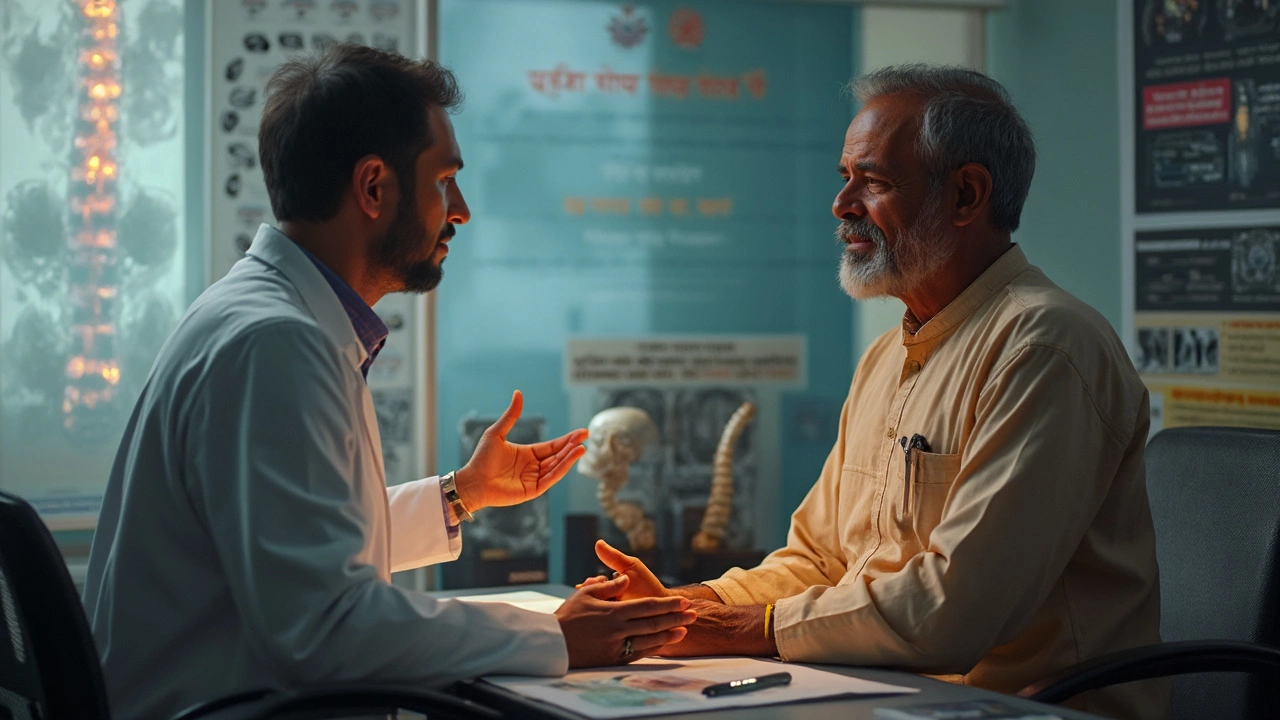Back pain doesn’t wait for a convenient time—it’ll hit during that long drive, in the middle of a work week, or right as you’re bending down to pick up something light. Suddenly you’re left wondering, “Who actually takes care of this pain? What is a back doctor called?”
The short answer? Most people call them spine specialists, but the official names are a little more specific. Usually, an orthopedic surgeon or a neurosurgeon treats back and spine issues. Some folks might see a physiatrist (that’s a doctor trained in physical medicine), especially if surgery isn’t the first step.
If you walk into any good orthopedic hospital, you’ll probably spot a few of these experts on staff. Orthopedic surgeons focus on bones, joints, and everything that keeps your body moving safely. Neurosurgeons, on the other hand, are the pros when nerves or the spinal cord are in trouble. Both handle a wide range of back problems, from slipped discs to sciatica—and yes, they often work as a team.
Ever tried searching ‘back doctor’ online? You’ll get all sorts of results—chiropractors, physical therapists, pain specialists, even acupuncturists. The truth is, while these professionals can help with certain types of pain, only board-certified orthopedic surgeons and neurosurgeons have the training for complex spine problems or when surgery is needed. If you’re stuck with nagging pain or numbness, it’s smart to know who to call first.
- Who Are Back Doctors?
- Types of Spine Specialists
- When Should You Visit a Spine Doctor?
- What Happens During Your Visit?
- Tips for Managing Back Pain
Who Are Back Doctors?
Not all doctors are trained to handle serious back problems. When someone says they're seeing a back doctor, they're most likely talking about one of these three: orthopedic surgeons, neurosurgeons, or physiatrists. Each has their own specialty when it comes to treating back and spine issues.
Orthopedic surgeons focus on the bones, discs, and joints in your back. They handle things like herniated discs, fractured vertebrae, and even scoliosis. If your pain is coming from something worn out, broken, or out of place, the orthopedic surgeon is the pro to trust.
Neurosurgeons step in when your nerves or spinal cord are involved. They often treat compressed nerves, spinal tumors, or issues that need ultra-precise care around the spinal cord. If pain comes with numbness or weakness in your arms or legs, this is usually who a regular doctor sends you to.
Physiatrists, also called physical medicine and rehabilitation doctors, help when surgery isn’t the first option. They focus on diagnosing why your back hurts and can start you on physical therapy, medications, or injections that help control pain. They don’t do surgery—but they know who to send you to if you need it.
Sometimes, you’ll run across other pros like chiropractors or pain specialists. Here's a quick breakdown comparing the main types of back doctors:
| Type of Doctor | What They Treat | Surgery | Common Procedures |
|---|---|---|---|
| Orthopedic Surgeon | Bones, discs, joints | Yes | Discectomy, spinal fusion, laminectomy |
| Neurosurgeon | Nerves, spinal cord | Yes | Microdiscectomy, tumor removal, decompression |
| Physiatrist | Pain, function problems, rehab | No | Physical therapy, injections, medications |
Fun fact: According to data from orthopedic hospitals in India, about 80% of adults experience back pain at some point, but only a small number actually need surgery. Most folks start with rehab or non-surgical care before considering more extreme options.
So the next time someone asks, “Who should I see for my back pain?” you’ll have a better idea than just saying “a back doctor.” The right specialist makes a big difference in recovery and cutting down your pain days.
Types of Spine Specialists
If you’re looking for someone to sort out your back pain, there’s more than just one kind of doctor you can see. Each type of specialist brings something unique to the table. Knowing who does what can help you figure out who to trust with your spine.
- Orthopedic surgeon: This is the go-to expert for issues with bones, joints, discs, and ligaments. If you need surgery for a herniated disc, spinal stenosis, or even scoliosis, this is your person. They don’t just operate—they also handle diagnosis, physical therapy recommendations, and injections.
- Neurosurgeon: Don’t let the name fool you—neurosurgeons spend a ton of their time working on spinal problems, especially when nerves are involved. If you’ve got nerve compression, spinal tumors, or tricky pinched nerves, they’re the specialists to trust.
- Physiatrist (Physical Medicine & Rehabilitation specialist): Not every back problem needs surgery. Physiatrists are trained to help you heal with non-surgical treatments like targeted exercise programs, pain management, and medications. They're your main contact for getting back on track without an operation.
- Pain Management Specialist: When back pain just won’t quit, these doctors help with injections, nerve blocks, and pain-relief plans. They work closely with surgeons and physiatrists for tough cases.
It’s handy to know that there’s more than one route to relief. According to a 2023 report from the American Academy of Orthopaedic Surgeons, about 70% of adults will deal with back pain at some point, so these specialists are busier than ever.
| Specialist Type | Main Focus | When You Should See Them |
|---|---|---|
| Orthopedic Surgeon | Bones, joints, discs, surgical care | Chronic back pain, disc problems, spine injuries |
| Neurosurgeon | Spinal nerves, spinal cord, surgery | Nerve pain, spinal tumors, neurological symptoms |
| Physiatrist | Non-surgical rehab, pain relief, mobility | Muscle pain, functional loss, recovery plans |
| Pain Specialist | Pain management, injections, nerve blocks | Persistent pain after other treatments |
Don’t get stuck thinking you only have one option for dealing with back pain. The right kind of back doctor depends on what’s actually going on with your spine, so you might start with one and end up seeing another. The most important thing? Don’t wait around hoping it gets better—know who you can turn to for real answers.

When Should You Visit a Spine Doctor?
So, how do you know it’s time to stop hoping your back pain will just go away and actually see a specialist? Some back pain is run-of-the-mill — maybe from lifting groceries wrong or standing too long. But sometimes, pain is a warning sign your body won’t let you ignore.
Here’s when you should book an appointment with a back doctor right away:
- Pain that sticks around for more than two weeks without getting better. If you’ve popped painkillers and tried stretching but still can’t kick it, you need to get checked out.
- Shooting pain, tingling, or numbness that travels down your leg or arm (classic signs of sciatica or a pinched nerve).
- Sudden weakness in your arms or legs. Even if it feels small, don’t ignore it.
- Trouble controlling your bladder or bowels—this is a red flag called “cauda equina syndrome,” and you should get help fast.
- Serious injuries—like from a car accident or a hard fall—where back pain starts after the incident. Don't play tough guy here.
- Pain that wakes you up at night or won’t let you sleep in any position.
- Unexplained weight loss along with constant back pain can sometimes mean there’s something bigger going on, like an infection or tumor. Better safe than sorry.
If you’re just dealing with a dull ache that comes and goes, rest and simple home remedies might be enough for a while. But ignoring chronic or severe pain can turn a small problem into a big one.
Here’s a quick breakdown of when most people finally go see a spine doctor, based on clinic records:
| Reason for Visit | Percentage of Patients |
|---|---|
| Pain not improving after 2+ weeks | 42% |
| Shooting/numbness in legs or arms | 29% |
| Weakness or loss of feeling | 14% |
| Injury or trauma | 8% |
| Other (weight loss, bladder issues, etc.) | 7% |
If any of these sound a little too familiar, it’s time to get in touch with the pros. They’ve seen it all—and acting early makes a massive difference in your recovery.
What Happens During Your Visit?
So, you’ve booked an appointment with a back doctor. What actually goes on behind that clinic door? Don’t expect fancy gadgets right away. Most visits start with a straightforward chat about how your pain started, where it hurts, and how it affects your life. They’ll ask about your job, habits, sports, past injuries, and how you sleep. Being honest here can be a game-changer for your treatment plan.
Next up, you’ll go through a physical exam. The specialist will watch how you stand, sit, bend, and walk. They’ll check your reflexes, test your muscle strength, and ask you to move in ways that might feel a little awkward at first. This helps them nail down what’s actually wrong and how severe it is. Most doctors say that about 80% of diagnoses start to shape up from just talking and examining, even before any tests.
If anything needs clarifying, expect to get sent for imaging tests like X-rays, MRIs, or CT scans. These pictures reveal what’s happening beneath the surface—bulging discs, pinched nerves, or arthritis show up here. Here’s a quick look at which tests check for what:
| Test Name | What It Shows |
|---|---|
| X-ray | Bone fractures, arthritis, bone alignment |
| MRI | Disc problems, nerve compression, soft tissue damage |
| CT scan | Detailed bone and soft tissue images, good for complex injuries |
If you’re nervous, you’re not alone. Plenty of people walk in thinking surgery is a given, but in reality, most back pain can be treated without it. As Dr. Michelle Rodriguez, a spine specialist at a top orthopedic hospital in Delhi, points out:
“Most patients don’t need surgery. The best care combines targeted physical therapy, pain management, and only as a last resort—surgery.”
Here’s what usually happens during your first visit, step by step:
- Medical history discussion
- Physical examination and movement tests
- Review of any previous scans or test results
- Ordering new imaging or lab tests (if needed)
- Talking through possible treatments and next actions
Be ready with questions: What’s the likely cause of your pain? What can you do at home? What activities should you avoid? Prepping a list of symptoms and concerns before your visit helps you get clearer answers and more personal advice, instead of just going with the flow.

Tips for Managing Back Pain
If your lower back’s feeling cranky, you’re not alone. According to a 2024 study from the Indian Journal of Orthopaedics, nearly 60% of adults will deal with back pain at some point in their lives. The good news is, most back pain actually gets better with simple steps at home. Still, ignoring the signs or resting too much won’t do you any favors. Here are things worth trying and what the stats really say.
- Stay Active: This might sound weird, but lying in bed can actually slow your recovery. Gentle walking or stretching, even for 20-30 minutes a day, keeps your joints and muscles from stiffening up.
- Fix Your Posture: Slouching at your desk or hunching over your phone adds extra stress to your back. Try to keep your feet flat on the ground and your shoulders relaxed. Use a chair with good lumbar support if you work long hours at a computer.
- Heat and Ice: Both can help, but for most people, ice works best in the first 48 hours to reduce swelling. After that, heat pads will relax tight muscles.
- Watch Your Lifting: Use your legs instead of your waist. That old-school advice—"lift with your knees, not your back"—really does help avoid strain.
- If you smoke, quit: It’s not just your lungs—smoking slows blood flow to your spine, which can make healing take longer.
If you’re seeing a back doctor, keep a log of your symptoms. Jot down what activities make it worse or better, how intense the pain feels, and any other odd symptoms like tingling or numbness. This helps your doctor figure out what’s going on faster.
Wondering when it’s time to get help? Here’s a simple cheat sheet:
- The pain lasts more than a few weeks
- Pain shoots down your legs or into your feet
- You notice weakness, numbness, or trouble controlling your bladder/bowel
And hey, a bit of prevention goes a long way. People who exercise regularly and keep their core strong are less likely to have back trouble. Here’s a quick look at what works best for most folks dealing with back pain, based on real numbers:
| Method | Reported Improvement (2024 survey, %) |
|---|---|
| Daily stretches | 67% |
| Physiotherapy | 80% |
| Yoga/simple core exercises | 74% |
| Medication (short-term) | 62% |
Every back is a little different, so try out a few things and see what helps. But if your pain is stopping you from living normally, get checked by a specialist sooner than later. Waiting too long never helps.





